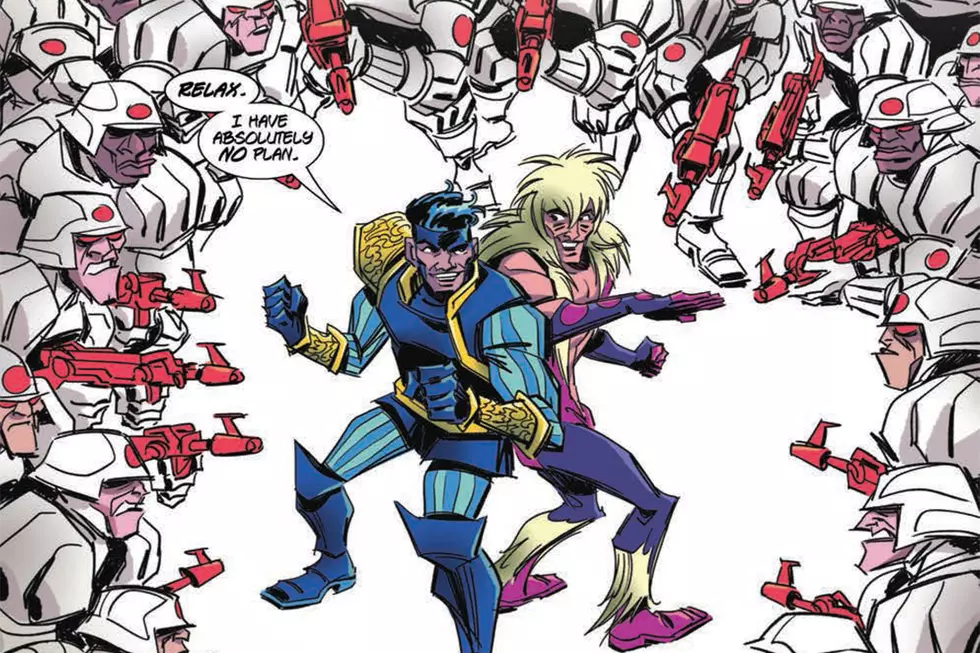
IDW’s ‘Samurai Jack’ Is A Time-Spanning Epic You Need In Your Life
Like everyone else who had eyes, I was a big fan of Samurai Jack when it first showed up on TV. I loved that show, and the visual style and breathtaking animation that took the risk of sparse dialogue and radical shifts in tone were mind-blowing, and in a lot of ways paved the way for a lot of shows that followed. But while I loved the show while it was on, I wasn't so much of a fan that I was really excited about the announcement that it was going to be revived as a comic from IDW. Don't get me wrong, I'm as big a fan of Jim Zub and Andy Suriano as you're likely to find, but I wasn't quite sure how a show that had relied so much on striking, fluid motion for its visual design would make the transition to the relatively static world of comics.
As it turns out, it took to it beautifully, and if you sit down and read the first fifteen issues of the ongoing series, you'll see how well they come together as one vast, epic story that takes Jack in every possible direction -- just like the show.
If you haven't been keeping up with it, the story that just wrapped up was called "The Quest of the Broken Blade," and as you might expect from that title, it's all about Jack's magic sword being broken in an attempt to get him back to his own time. It's a pretty compelling story, and it's done very well, but it's actually the culmination of what Zub, Suriano, and other artists started back in their first story arc.
Before I get to that, though, a quick word about the art on this book: It is fantastic, even when it's other artists filling in for Suriano. It's always interesting to see a cast of artists take on something that has such a defined aesthetic -- an aesthetic that Suriano worked on as an animator and character designer -- especially when it's something that's as rigidly defined by its visuals as Samurai Jack. It's really fun to see what different artists can bring to the table while still working on-model, and in Jack's case, everyone works exceptionally well.
Andy Kuhn in particular does a great job in his issue. He's my pick for one of the most underrated artists in comics, and he slides right into Samurai Jack, fitting in perfectly with a story of Aku going into Jack's memories in an attempt to destroy the knowledge that has made him the man he is -- and ends up facing Jacks from all different eras of his life, teaming up to boot him right out of our hero's subconscious mind.
Now that I look at it, I would maybe question the wisdom of firing arrows that pin a shapeshifting demon to one's own brain, but whatever. It looks awesome.
And really, it's a key point for the progression of the series. Zub and Suriano start out with "The Threads of Time," a story that seems like a pretty basic fetch-quest sort of mission for Jack: There's a mystical rope with time travel powers that's been shredded, but if he gets back the threads, he can wind them back together and use the resulting rope to go back in time. It's a classic MacGuffin, to the point where he might as well be going to rescue seven maidens in Hyrule, but it gives the creators a chance to explore different ideas about just what time means. That arc has stories about memories, synchronicity, aging, and other things that might not come to mind when you think about a story that's rooted in time travel, and it goes a long way towards showing just how clever this book is.
But it also sets up a recurring idea in Samurai Jack, one that sees challenges that appear to be physical, but turn out to be things that Jack ends up having to think his way out of instead. It's how every issue of the series is built; after the first issue, it's never a straight fight, whether it's a matter of just figuring out a villain's weak point or, you know, being transformed by leprechauns into a gender-swapped version of himself alongside the Scotsman and his machine-gun leg, as in the story drawn by Brittney Williams.
That sort of thing tends to happen with your more mystical heroes.
The end result of all this is that we see Jack being pushed to his mental limits throughout the series as it builds. The physicality is never in question; the first thing that happens in the series is that Jack takes on five formidable warriors, including a stumpy parody of Wolverine, so it's well established even if you've forgotten the show that he's a pretty capable warrior. The trick is that all those challenges, even when they're purely mental, are represented on a physical level that keeps the action moving.
And when the sword breaks, it all comes together.
The sword is, after all, the ultimate representation of Jack's physical power, forged by gods from different pantheons and handed down from his father, but in this story, it's also recast as the ultimate expression of his mental power. It's shown as his willpower and honor given form, thematically tying together everything that the series has done up to that point. Like everything else, it seems like it's a physical challenge -- how's Jack going to beat Aku when he can only rely on his bare hands? -- but it quickly turns into a metaphysical one, with Jack going on a journey that's downright spiritual.
It's a good story, but it's also A Pretty Big Deal. It's the kind of thing that changes a core idea about the show, something that the comic probably wouldn't be able to get away with if Samurai Jack was still on the air, but that's also interesting and very, very well done.
"Epic" is a word that gets tossed around a lot, but Samurai Jack lives up to it. It's a vast adventure that works on multiple levels, and if you haven't been reading the series, it's absolutely worth catching up.
More From ComicsAlliance







![Jim Zub And Djibril Morissette-Phan Explore The Dark Side Of Hollywood In ‘Glitterbomb’ [Interview]](http://townsquare.media/site/622/files/2017/02/Glitterbomb-Featured.png?w=980&q=75)

